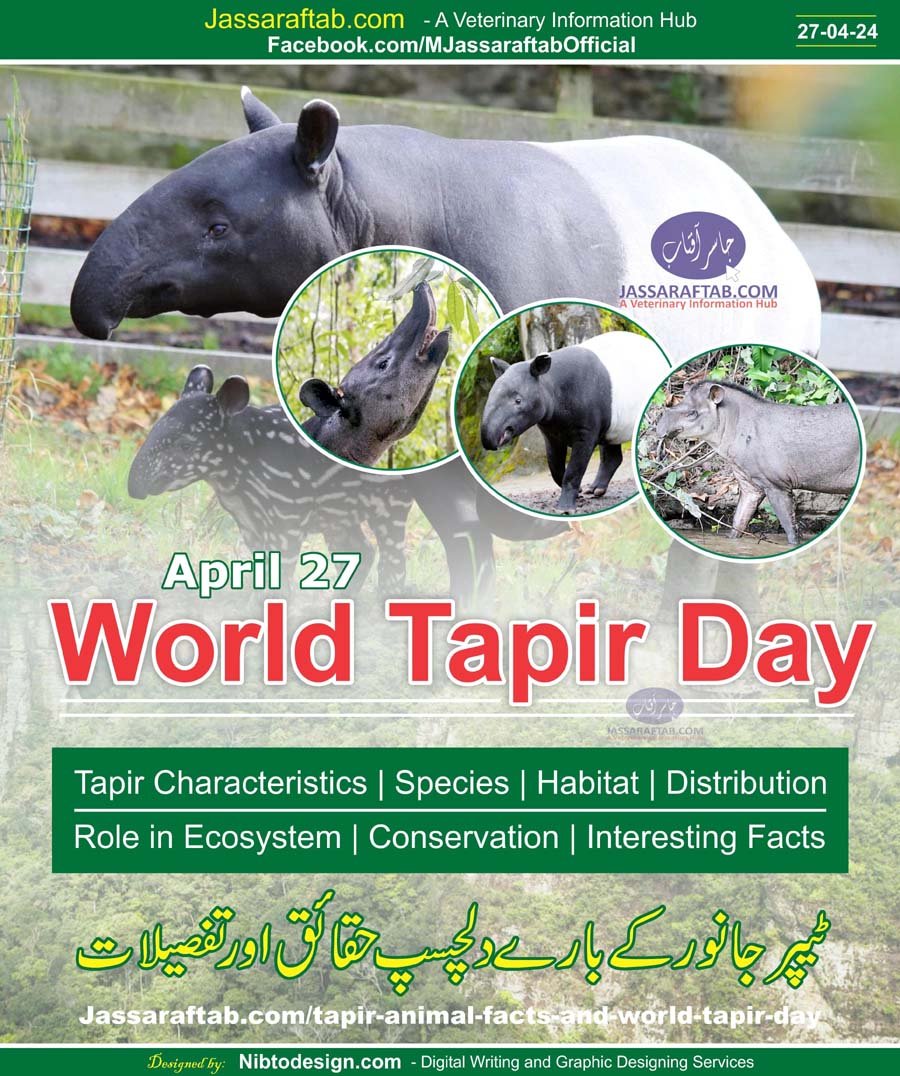
World Tapir Day | Tapir Animal Characteristics
World Tapir Day is celebrated on April 27 every Year. This Day of Tapir Animal (ٹیپر ) is observed to raise awareness about Tapir species. Furthermore, the purpose of this day is to raise awareness for Tapir Conservation and protection of Tapir Habitat. Tapir characteristics and Tapir Facts make this the interesting animal.
World Tapir Day celebration started in 2008. Efforts of Tapir conservationists are behind this step. Their main purpose in celebrating World Tapir Day was to highlight the role of this animal in the ecosystem.
Tapir Characteristics – Tapir Animal
Tapir is an animal which is a herbivorous mammal. Its physical appearance looks like pigs and hippos. But, on the other hand, it is closely related to horses and rhinoceros according to Tapir Characteristics and Tapir Habitat. Moreover, its size varies between Tapir species.
The Most Difficult Births in Animals
Some tapir facts related to color and shape. The color of Tapir Animal ranges from reddish brown to grey and blackish. But, Malayan tapir has a white, saddle-shaped marking on its back. All Tapirs have small oval, white-tipped, and rounded ears. They have small brown eyes and teardrop-shaped bodies. However, mountain tapirs have wooly fur on their back. Tapirs have stubby tail and hooved toes. Moreover, they have four toes on the front feet and three on the hind feet. Due to this, they can walk on muddy and soft ground.

They have flexible and short snout which is actually an extended nose and upper lip. It looks like an Elephant Trunk. This trunk helps them to pluck fruits and grab tree branches. In addition, they can also use it as snorkel when they go underwater. Also, they also use it to detect odors. Besides a strong sense of smell, they have sensitive ears. In fact, these Tapir Characteristics make and Tapir Facts enhanced interest in this animal.
Tapir Distribution and Tapir Habitat
Tapir Animal is found in Central America, South America, South East Asia, Colombia, Argentina, Brazil, Sumatra, Malaysia, and Thailand. On the other hands, Tapir habitat is in regions with good water sources, grasslands, woods, mountains, forests, wetlands, Savanna and rainforests. However, they prefer to live in wooded and grassy areas during the daytime. Besides this, they can swim and take dip in river, lake and pond.
Honey Bee and its Waggle Details
Tapir Animal Species
Four recognized Tapir species exist. Tapir Distribution is different for these Tapir species. One founds in South East Asia and three in Central and South America.
Baird’s Tapir
This is also called the Central American Tapir. They have dark reddish brown to black coats. Their chest and chin are white. Also, the tips of the ears are white.
Brazilian Tapir
They are also called the South American Tapir or Lowland Tapir. Their body color is dark on the back and lighter on the underside. Moreover, they prefer to live in warm, rainy, and humid conditions.
Mountain Tapir
Another name for Mountain Tapir is Woolly Tapir. They have thick woolly coats. And this is one of the world’s endangered species of Mammals.
Malayan Tapir
This is the only species of Tapir present in Asia. They have a distinctive coat. Their coat is black in the front and white in the back.
Tapir Conservation
Many projects of Tapir conservation have been started around the world for different Tapir Species. These programs are working to restore their species and the remaining Tapir habitats. However, all species for Tapir Animal are on the IUCN red list as endangered species. A research and conservation organization “Lowland Tapir Conservation” has focused on Tapir conservation in Brazil.
Humans are the main threat to Tapirs. Humans are hunting them for their meat and hide. Besides this, leopards and tigers are the main predators of Tapirs. However, they protect themselves from predators by hiding in nearby water sources. Including this, humans are also damaging their habitat through deforestation and hunting.
Facts about Markhor Conservation
Tapir Animal role in the ecosystem
Tapirs play an important role in the ecosystem. Because they are hindgut fermenters and have an enlarged Cecum. They are seed dispersers by facilitating the dispersal of seeds over long distances. Therefore, Tapirs are capable of depositing large seeds in the best places for germination. They eat a variety of seasonal fruits and disperse their seeds at different places. Through this process, they help to regrow new plants and fruits. Due to this, they called gardeners of the forest.







11 Comments
You can protect yourself and your stock close being heedful when buying prescription online. Some pharmacopoeia websites operate legally and offer convenience, solitariness, bring in savings and safeguards over the extent of purchasing medicines. buy in TerbinaPharmacy https://terbinafines.com/product/motrin.html motrin
This is the gentle of literature I positively appreciate. TerbinaPharmacy
More posts like this would prosper the blogosphere more useful.
Tham gia cộng đồng game thủ tại Go88 để trải nghiệm các trò chơi bài, poker phổ biến nhất hiện nay.
kuwin sở hữu kho game đa dạng từ slot đến trò chơi bài đổi thưởng, mang đến cho bạn những giây phút giải trí tuyệt vời.
采用高效谷歌外推策略,快速提升网站在搜索引擎中的可见性与权重。谷歌外推
Khám phá thế giới giải trí trực tuyến đỉnh cao tại MM88, nơi mang đến những trải nghiệm cá cược thể thao và casino sống động.
利用强大的谷歌蜘蛛池技术,大幅提升网站收录效率与页面抓取频率。谷歌蜘蛛池
Đến với J88, bạn sẽ được trải nghiệm dịch vụ cá cược chuyên nghiệp cùng hàng ngàn sự kiện khuyến mãi độc quyền.
Với giao diện mượt mà và ưu đãi hấp dẫn, MM88 là lựa chọn lý tưởng cho các tín đồ giải trí trực tuyến.
iwin – nền tảng game bài đổi thưởng uy tín, nơi bạn có thể thử vận may và tận hưởng nhiều tựa game hấp